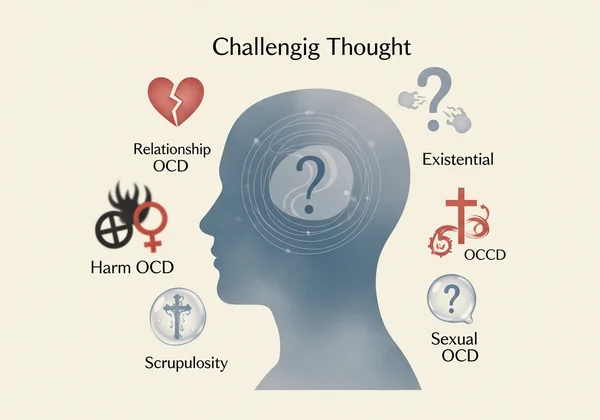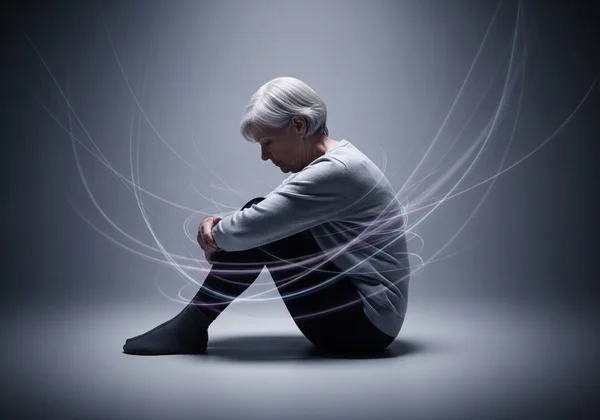Pure O OCD Test: Understanding Hidden Obsessions
Do you experience unsettling thoughts you can't shake, but without obvious physical compulsions? You might be grappling with Pure O, a misunderstood form of OCD. Do I have OCD test and wonder why my symptoms don't fit the common portrayals? This guide will help you understand what Pure O is, its hidden nature, and how to begin finding clarity. Understanding your experiences is the first step toward feeling better. A discreet self-assessment can provide valuable initial insights. If you're seeking a confidential starting point, consider taking a free and scientifically-informed Pure O OCD Test at OCDTest.net.

What is Pure O OCD? Defining Purely Obsessional OCD
"Pure O" is a common term used to describe a presentation of Obsessive-Compulsive Disorder (OCD) where the compulsions are primarily mental rather than observable physical rituals. The name "Pure O" can be misleading because it suggests there are no compulsions, but rather these compulsions occur internally. Individuals with pure o experience intense, unwanted, and intrusive thoughts, images, or urges that cause significant distress. These mental events are obsessions, and the hidden acts performed to neutralize them are mental compulsions.
The Core of Obsessions: Unwanted Intrusive Thoughts
The hallmark of Pure O is the presence of unwanted intrusive thoughts. These are not just fleeting worries or concerns; they are persistent, ego-dystonic thoughts that feel alien and often deeply disturbing. They can be violent, sexual, blasphemous, or otherwise taboo in nature, causing immense distress and leading the individual to question their character or sanity. Despite their disturbing content, these thoughts are typically inconsistent with the person's true values or intentions.
Common Themes in Pure O: Beyond Typical Worries
Intrusive thoughts in Pure O often revolve around specific themes that cause intense anxiety and moral distress. These themes commonly include:
- Harm OCD: Fears of accidentally or intentionally harming others or oneself.
- Sexual OCD: Disturbing sexual thoughts or images, often involving taboo subjects like pedophilia or incest.
- Religious/Moral Scrupulosity OCD: Obsessions about sin, morality, or offending God.
- Relationship OCD (ROCD): Doubts and anxieties about the suitability or authenticity of one's romantic relationships.
- Existential/Philosophical OCD: Obsessions about the meaning of life, reality, or the universe.
- "Just Right" OCD: A feeling that something isn't "just right" and performing mental actions until it feels resolved.
These themes go far beyond typical worries, consuming thoughts and often causing profound anxiety, guilt, and shame.

Mental Compulsions: The "Hidden OCD" Mechanism
The defining characteristic of hidden OCD or Pure O is the covert nature of its compulsions. Unlike overt behaviors like checking locks or washing hands repeatedly, these compulsions happen entirely within the mind. They are a desperate attempt to neutralize the anxiety caused by the obsessions or prevent feared outcomes. Understanding these internal rituals is key to recognizing Pure O. To gain clarity on whether your experiences align with these patterns, a confidential online OCD test can be very illuminating.
Inside the Mind: Ruminating, Analyzing, and Reassurance Seeking
People with Pure O engage in complex mental compulsions to cope with their intrusive thoughts. These include:
- Rumination: Endless mental review or analysis of a thought or situation, trying to "figure it out" or definitively resolve it. This can involve replaying scenarios or seeking perfect certainty.
- Thought Neutralization: Attempting to "undo" a bad thought by thinking a "good" thought or performing a mental ritual.
- Reassurance Seeking: Constantly seeking internal or external reassurance that fears won't come true, or that one is a good person. This often manifests as replaying conversations or mentally debating moral dilemmas.
- Mental Checking: Repeatedly reviewing memories or feelings to confirm a thought isn't true or a feared event hasn't happened.
- Prayer/Bargaining: Using religious rituals or making mental deals to prevent feared outcomes.
These internal struggles are exhausting and often leave individuals feeling isolated, as no one can see their constant mental battles.

Why Pure O is Often Misunderstood
The lack of observable physical compulsions makes Pure O particularly insidious and difficult to identify, both for the individual experiencing it and for others. Friends and family might not notice anything amiss, leading to feelings of profound loneliness and isolation. Even mental health professionals might initially mistake Pure O for generalized anxiety disorder, depression, or even a psychotic disorder if they are not specifically trained in OCD subtypes. This misunderstanding often delays proper diagnosis and effective treatment. Many people only search for a pure ocd test after years of suffering in silence.
How Pure O Impacts Daily Life & Wellbeing
The impact of Pure O, though hidden, is profound and far-reaching. The relentless cycle of obsessions and mental compulsions can severely diminish quality of life, affecting emotional stability, relationships, and daily functioning. Taking a moment to reflect on your own experiences can be a powerful step. You can start this journey of understanding with a free self-assessment designed to provide initial insights into your symptoms.
The Emotional Toll: Anxiety, Guilt, and Shame
The constant barrage of intrusive thoughts and the effort to suppress them or neutralize their impact lead to overwhelming anxiety. Individuals often experience intense guilt and shame over the content of their obsessions, believing these thoughts reflect their true character. This can result in:
- Depression: The chronic stress and despair from internal battles can lead to depressive episodes.
- Social Withdrawal: Fear of acting on disturbing thoughts or being "found out" can lead to isolation.
- Low Self-Esteem: The belief that one is a "bad" person because of the unwanted thoughts.
- Emotional Exhaustion: The continuous mental effort is mentally draining.
The emotional burden of Pure O can be as debilitating as, if not more than, the physical symptoms of traditional OCD.

Distinguishing Pure O from General Anxiety or Overthinking
It's common to wonder, "Is this just anxiety, or is it Pure O?" While both involve worry, the distinction lies in the nature of the thoughts and the presence of compulsions.
- General Anxiety: Worries tend to be about real-life concerns (finances, health, future), though they might be excessive. There are no associated compulsive behaviors (mental or physical) aimed at neutralizing the anxiety beyond typical problem-solving.
- Overthinking/Rumination (non-OCD): People can overthink problems or dwell on past events. However, in OCD, the thoughts are ego-dystonic (not aligned with one's self-image or desires), highly distressing, and accompanied by specific, repetitive mental compulsions aimed at reducing distress or preventing perceived harm. The cycle feels inescapable.
If you find yourself stuck in a relentless loop of distressing, unwanted thoughts and secret mental rituals to neutralize them, an ocd self test might offer some initial clarity.
Your Next Step with Pure O Concerns
Understanding pure o is the first vital step towards regaining control and improving your well-being. It's crucial to remember that you are not alone, and your experiences, though hidden, are valid. Recognizing the patterns of intrusive thoughts and mental compulsions can be incredibly validating and empowering.
If you suspect you might be experiencing Pure O, taking an initial Pure O OCD Test can provide a confidential starting point for self-assessment. Our platform offers a free, scientifically-informed online OCD test designed to help you understand potential symptoms. After your assessment, you can opt for an AI-personalized report that offers deeper insights into your specific patterns and challenges, guiding you toward informed next steps. This tool is a reliable preliminary screening and a safe, anonymous way to explore your symptoms. Begin your journey toward understanding your mental health by taking the test now: start your self-assessment.
Frequently Asked Questions About Pure O OCD
Many people have questions about this often-misunderstood form of OCD. Here are answers to frequently asked questions about Pure O OCD:
Can an online "Pure O OCD Test" really help me?
Yes, an online Pure O OCD Test can be a very helpful first step. While it cannot provide a clinical diagnosis—only a qualified mental health professional can do that—it can offer significant preliminary insights. Tools like the one at OCDTest.net are designed based on established psychological principles (like OCI or YBOCS) to help you recognize patterns that may indicate the presence of OCD symptoms. It's a confidential way to explore your experiences and decide if professional evaluation is warranted.
How do I know if my intrusive thoughts are Pure O and not just normal worries?
The key difference lies in the nature of the thoughts and your reaction to them. Normal worries are usually about realistic concerns and don't typically involve intense disgust or fear about your own character. Pure O intrusive thoughts are often ego-dystonic—meaning they conflict with your values—and are accompanied by significant distress and repeated mental compulsions aimed at neutralizing the thoughts or preventing feared outcomes. If your thoughts are persistent, highly distressing, feel out of your control, and lead to secret mental rituals, it's worth considering a self-assessment to explore further.
Does Pure O OCD ever go away on its own?
While symptoms of pure o can fluctuate in intensity, OCD, including Pure O, typically does not go away on its own. It's a chronic condition that often requires professional intervention for effective management. Without treatment, the cycle of obsessions and compulsions can become more entrenched and debilitating. However, with evidence-based therapies like Cognitive Behavioral Therapy (CBT) and Exposure and Response Prevention (ERP), significant improvement in symptoms and quality of life is highly achievable. Taking an initial OCD self-test can be a great way to start seeking clarity and understanding.
What triggers Pure O intrusive thoughts?
Pure O intrusive thoughts can be triggered by a wide range of internal or external stimuli. These triggers are highly individual but often relate to themes that are personally significant or anxiety-provoking. Common triggers can include: specific situations, people, objects, conversations, certain media content, or even internal sensations and feelings. Stress, fatigue, or changes in routine can also exacerbate the frequency and intensity of these thoughts. Identifying your triggers is an important part of understanding your unique experience with OCD, and an accurate OCD test can help you start exploring these patterns.